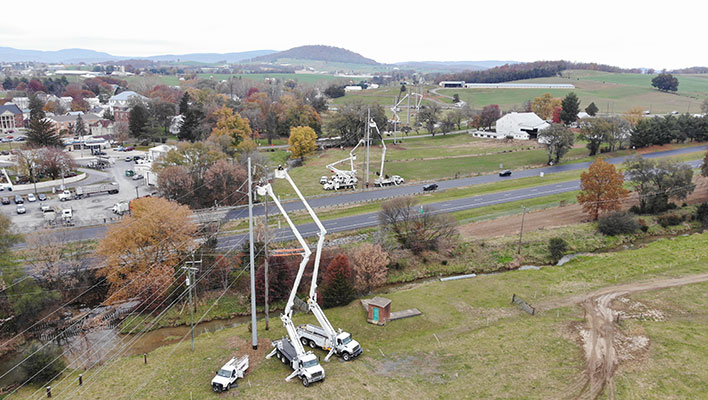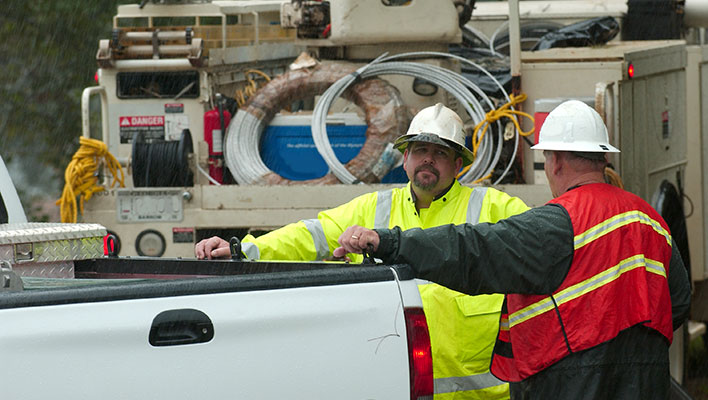As electric utility leaders think about the strategies needed to navigate the workforce mobility challenges of today and tomorrow, multiple business priorities are top of mind, including a big crew change that leaves teams understaffed and reliant on contractors, increasing storm events, and an urgent need to enhance situational awareness. Jason Rhoades, Customer Success Manager at ARCOS, brings his voice of authority to our blog where his 23 years of experience on the front lines of the electric industry make him uniquely qualified to provide pragmatic insights, from adoption of new technology and unleashing crew performance to managing a hybrid workforce and meeting even the darkest sky work head on with the digital utility of the future.
Most electric utilities today have fewer linemen than they once did and more work than they’ve ever had. Capital spending is higher than it’s ever been as communities grow. There’s everyday work that needs to get done, including constructing new circuits, meter work and inspections, routine maintenance, and keeping vegetation clear on right of ways. Adding complexity are increasing storm events and more severe weather, outages, equipment failure, and vehicles that knock down poles. Electric utilities are overworked and undermanned and they’re being asked to do more with less while improving safety and situational awareness. How?
About 5 years ago, the “big crew change” really started to accelerate but the electric utility industry is still at a big risk from retiring field workers. We’re losing experienced linemen faster than the industry is hiring junior apprentices. The result is an overall much younger crew with fewer foremen and A linemen, which is why many teams are promoting junior linemen faster than before.
Technology is half the battle to unleash mobile workforce productivity and the other half is user adoption, the topic of my last blog post in a series where I hope to explain what the digital utility of the future looks like. As I argued, if the technology adds complexity in the field, linemen will seek a path of least resistance and fallback on the tried and true techniques that date back to the 1930s.
The problem though is that digital transformation is now imperative and most of all, the few junior linemen that we are able to recruit were born in the digital age. They are digital-first problem solvers. Rather than seeing the situation as dire, I see all of this as an opportunity for our industry to make giant leaps forward and truly unleash the full potential of every worker, not just doing more with less but improving job satisfaction, safety, and situational awareness. These younger linemen are being promoted based on their leadership qualities, of course, but also their digital skillsets and willingness to use new tech. But you need to get that tech right.
Those in the industry know that boosting job performance is a function of utility crew culture. The hard reality is that we work in an extremely dangerous environment and that your life depends on the guy standing next to you. Management has their KPIs for performance, like callout percentage, but in the field, linemen hold each other accountable. This will always be important and if technology takes this into account, you’ve got a powerful tool.
For example, imagine a situation where a junior lineman misses a callout. He marches into the supervisor’s office the next morning and because his union rules say he gets a certain number of hours of work each week, the lineman is ready to file a grievance. Unperturbed because the company uses ARCOS Callout, the supervisor checks the callout log and the roster to find that indeed the junior lineman was supposed to be on the callout the night before. He also sees that the callout was made to the lineman’s home phone and plays the recording of the call wherein the man’s son is heard to answer the phone with the lineman’s voice in the background telling him to hang up. Problem solved.
For the new generation born into digital everything and on-demand access to information, technology is the force multiplier our industry needs. Key to this is providing a seamless switch from blue sky work into gray and vice versa in a single solution. And that solution must be a mobile app since crews already have the equipment in their pocket (BYOD: bring your own device!). Take a trouble ticket, crews might work 10 or 15 a day. Working in different apps for receiving the ticket from dispatch, plugging the location into a GIS app for navigation, communicating status and requirements for materials, can take several minutes just to get moving. All of these small delays add up to big waste as the lineman in this example spends more than 6 hours every week managing tickets. Paid wait time notwithstanding, he or she could have been attacking a high value problem or getting the lights back on faster. And when a storm hits, there’s different apps for that, creating app overload for crews.
Now imagine one app that handles dispatch, navigation, situational awareness, material requirements, and time keeping. Solutions like ARCOS Mobile Workbench are designed by linemen for linemen. Trouble tickets take a couple of taps and a few seconds to begin navigating to the job. Job details and hours are automatically booked. When field staff arrive at a site, the app goes with them instead of remaining bolted to the truck. Problems are solved faster, empowering field staff with more information to troubleshoot and improve customer satisfaction.
And that’s just one way mobile workforce management technology reduces waste and increases wrench time. There are many other areas of planned and unplanned work, short-cycle, and long-cycle jobs where tremendous efficiencies can be achieved. But it’s the ability to seamlessly switch between all of these – from routine maintenance to storm events, from damage assessment to repair – that makes such technology a game changer for our industry.
Not too long ago, unhappy electric utility customers could only complain to friends, family, and their church. But technology is a double-edged sword that unlocks workforce potential while exposing utility companies to instant scrutiny through social media the moment there’s a problem or outage. But with solutions like Mobile Workbench that capture photos and video of what’s actually happening on the ground, teams can respond faster than they ever have with information their customers need, providing a win-win for everyone. The technology checks all the boxes, from shrinking operational costs and accelerating every work type in the field to driving customer satisfaction and helping utilities manage public perception.
I’ve talked a lot about doing more with less but doing that also hinges on effectively integrating the contract workforce our industry has come to rely on with your digital transformation strategy. In my next blog post I’ll talk more about treating contractors like your own with technology to provide them with the same seamless switch, whether that’s for blue sky native contractors or for the truly daunting task of integrating thousands of non-native contractors for large scale disaster recovery and restoration. And as always, please reach out to me with any questions along the way.
Did you enjoy Jason’s blog? Check out his previous post: Building the Digital Utility of the Future: Past, Present, Future




